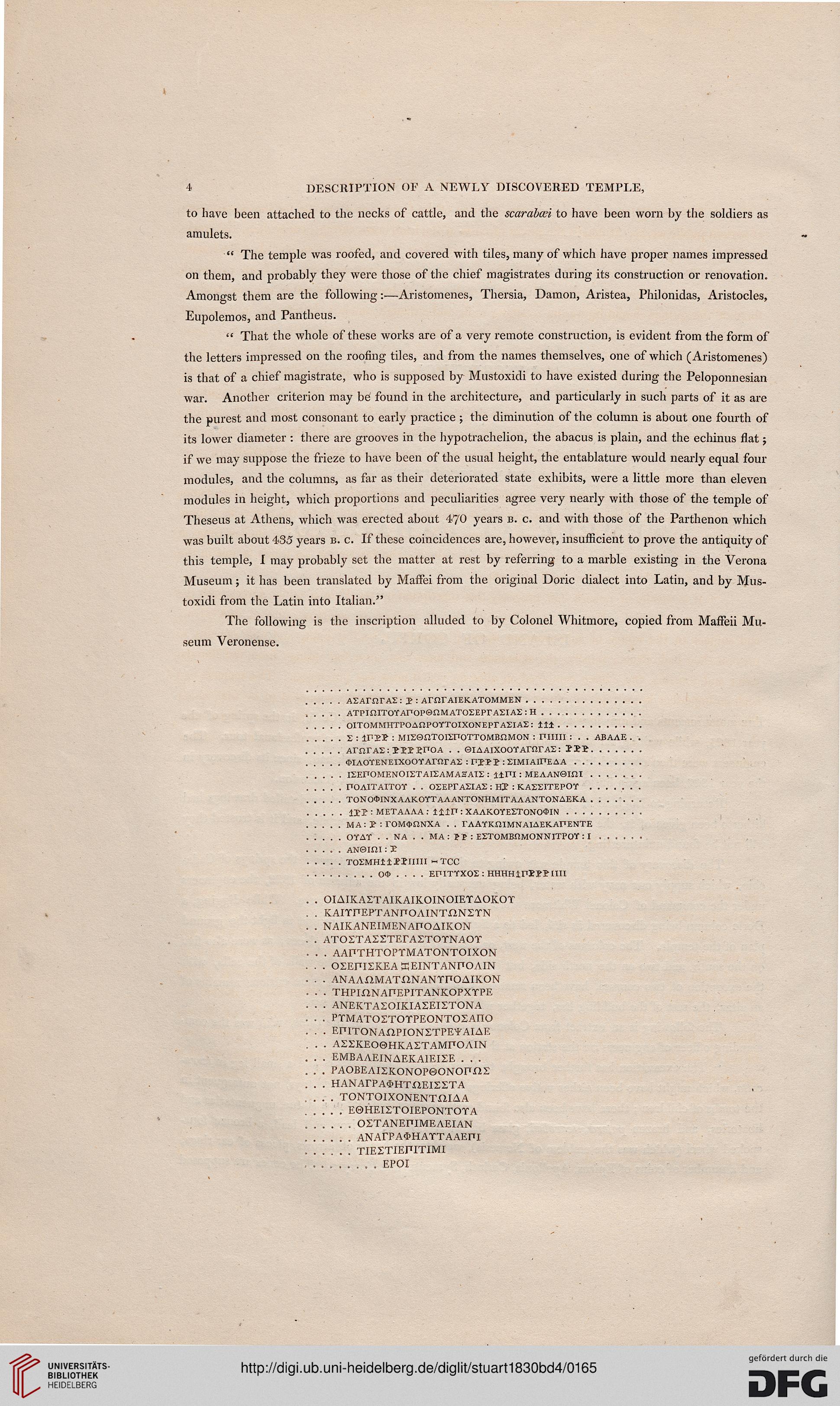4 DESCRIPTION OF A NEWLY DISCOVERED TEMPLE,
to have been attached to the necks of cattle, and the scarabai to have been worn by the soldiers as
amulets.
" The temple was roofed, and covered with tiles, many of which have proper names impressed
on them, and probably they were those of the chief magistrates during its construction or renovation.
Amongst them are the following :■—Aristomenes, Thersia, Damon, Aristea, Philonidas, Aristocles,
Eupolemos, and Pantheus.
" That the whole of these works are of a very remote construction, is evident from the form of
the letters impressed on the roofing tiles, and from the names themselves, one of which (Aristomenes)
is that of a chief magistrate, who is supposed by Mustoxidi to have existed during the Peloponnesian
war. Another criterion may be found in the architecture, and particularly in such parts of it as are
the purest and most consonant to early practice ; the diminution of the column is about one fourth of
its lower diameter : there are grooves in the hypotrachelion, the abacus is plain, and the echinus flat j
if we may suppose the frieze to have been of the usual height, the entablature would nearly equal four
modules, and the columns, as far as their deteriorated state exhibits, were a little more than eleven
modules in height, which proportions and peculiarities agree very nearly with those of the temple of
Theseus at Athens, which was erected about 470 years b. c. and with those of the Parthenon which
was built about 435 years b. c. If these coincidences are, however, insufficient to prove the antiquity of
this temple, I may probably set the matter at rest by referring to a marble existing in the Verona
Museum; it has been translated by Maffei from the original Doric dialect into Latin, and by Mus-
toxidi from the Latin into Italian."
The following is the inscription alluded to by Colonel Whitmore, copied from Maffeii Mu-
seum Veronense.
AEAmrAE: I : AmrAIEKATOMMEN.............
ATPmiTOTfAPOP©nMATO£EPrA2IA£ : H...........
OITOMMHTPOAUPOYTOIXONEPrASIAS : tit.........
X : IFEP : MISenTOISFOTTOMBfiMON : PIIIII : . . ABAAE ,
ArnrA2:mETOA . . ©iAAixooYArnrAS: !■£?.....
OIAOYENEIXOOYArnrAS :U^T-J:2IMIAinEAA.......
ISEPOMENOIETAIEAMASAIE : ±±PI : MEAAN0HH.....
POA1TAITOY . . OSEPrASIAS : Hj : KA22ITEPOY .....
TONO0INXAAKOYTAAANTONHMITAAANTONAEKA .....
11? : METAAAA : 1±1F : XAAKOYE£TONO<J>IN........
MA : F : TOMOUNXA . . TAAYKniMNAlAEKAPENTE
OYAY . . NA . . MA: £* : ESTOMBDMONNITPOY : I ....
AN0IJ2I: 3?
TOXMH1 ±1211111 -<TCC
. . . . O* . . - . EFITYX02:HHHHlP3fI>?niI
OIAIKAITAIKAIKOINOIETAOKOT
KAITPEPTANnOAINTHNSTN
NAIKANEIMENAPOAIKON
ATOSTASSTErASTOTNAOT
. AAPTHTOPYMATONTOIXON
. OSEPISKEASEINTANPOAIN
. ANAAXIMATXINANTPOAIKON
• THPinNAPEPITANKOPXTPE
. ANEKTA20IKIA2EI2TONA
. PTMATOSTOTPEONTOSAnO
. EPITONAflPIONSTPEYAIAE
. A22KEO0HKA2TAMPOAIN
. EMBAAEINAEKAIEI2E . . .
. PAOBEAISKONOPQONOPnS
. HANArPA$HTftEI2£TA
. . TONTOlXONENTmAA
. . . E0HEISTOIEPONTOTA
.... OSTANEPIMEAEIAN
.... ANArPAOHATTAAEPI
.... TIESTIEPITIMI
.......EPOI
to have been attached to the necks of cattle, and the scarabai to have been worn by the soldiers as
amulets.
" The temple was roofed, and covered with tiles, many of which have proper names impressed
on them, and probably they were those of the chief magistrates during its construction or renovation.
Amongst them are the following :■—Aristomenes, Thersia, Damon, Aristea, Philonidas, Aristocles,
Eupolemos, and Pantheus.
" That the whole of these works are of a very remote construction, is evident from the form of
the letters impressed on the roofing tiles, and from the names themselves, one of which (Aristomenes)
is that of a chief magistrate, who is supposed by Mustoxidi to have existed during the Peloponnesian
war. Another criterion may be found in the architecture, and particularly in such parts of it as are
the purest and most consonant to early practice ; the diminution of the column is about one fourth of
its lower diameter : there are grooves in the hypotrachelion, the abacus is plain, and the echinus flat j
if we may suppose the frieze to have been of the usual height, the entablature would nearly equal four
modules, and the columns, as far as their deteriorated state exhibits, were a little more than eleven
modules in height, which proportions and peculiarities agree very nearly with those of the temple of
Theseus at Athens, which was erected about 470 years b. c. and with those of the Parthenon which
was built about 435 years b. c. If these coincidences are, however, insufficient to prove the antiquity of
this temple, I may probably set the matter at rest by referring to a marble existing in the Verona
Museum; it has been translated by Maffei from the original Doric dialect into Latin, and by Mus-
toxidi from the Latin into Italian."
The following is the inscription alluded to by Colonel Whitmore, copied from Maffeii Mu-
seum Veronense.
AEAmrAE: I : AmrAIEKATOMMEN.............
ATPmiTOTfAPOP©nMATO£EPrA2IA£ : H...........
OITOMMHTPOAUPOYTOIXONEPrASIAS : tit.........
X : IFEP : MISenTOISFOTTOMBfiMON : PIIIII : . . ABAAE ,
ArnrA2:mETOA . . ©iAAixooYArnrAS: !■£?.....
OIAOYENEIXOOYArnrAS :U^T-J:2IMIAinEAA.......
ISEPOMENOIETAIEAMASAIE : ±±PI : MEAAN0HH.....
POA1TAITOY . . OSEPrASIAS : Hj : KA22ITEPOY .....
TONO0INXAAKOYTAAANTONHMITAAANTONAEKA .....
11? : METAAAA : 1±1F : XAAKOYE£TONO<J>IN........
MA : F : TOMOUNXA . . TAAYKniMNAlAEKAPENTE
OYAY . . NA . . MA: £* : ESTOMBDMONNITPOY : I ....
AN0IJ2I: 3?
TOXMH1 ±1211111 -<TCC
. . . . O* . . - . EFITYX02:HHHHlP3fI>?niI
OIAIKAITAIKAIKOINOIETAOKOT
KAITPEPTANnOAINTHNSTN
NAIKANEIMENAPOAIKON
ATOSTASSTErASTOTNAOT
. AAPTHTOPYMATONTOIXON
. OSEPISKEASEINTANPOAIN
. ANAAXIMATXINANTPOAIKON
• THPinNAPEPITANKOPXTPE
. ANEKTA20IKIA2EI2TONA
. PTMATOSTOTPEONTOSAnO
. EPITONAflPIONSTPEYAIAE
. A22KEO0HKA2TAMPOAIN
. EMBAAEINAEKAIEI2E . . .
. PAOBEAISKONOPQONOPnS
. HANArPA$HTftEI2£TA
. . TONTOlXONENTmAA
. . . E0HEISTOIEPONTOTA
.... OSTANEPIMEAEIAN
.... ANArPAOHATTAAEPI
.... TIESTIEPITIMI
.......EPOI




